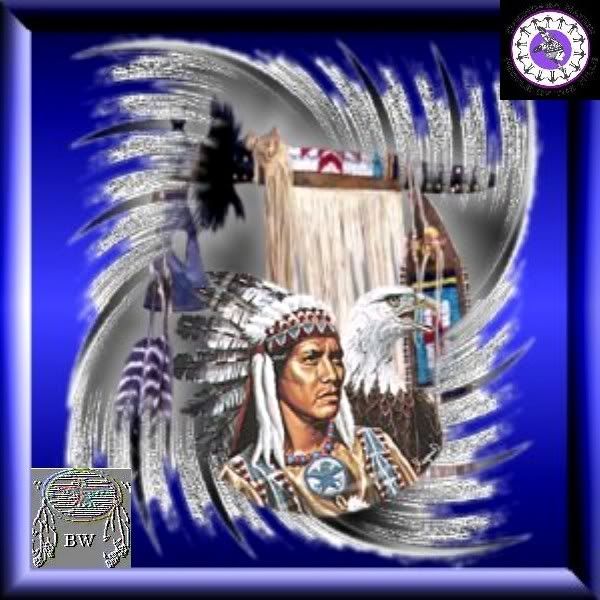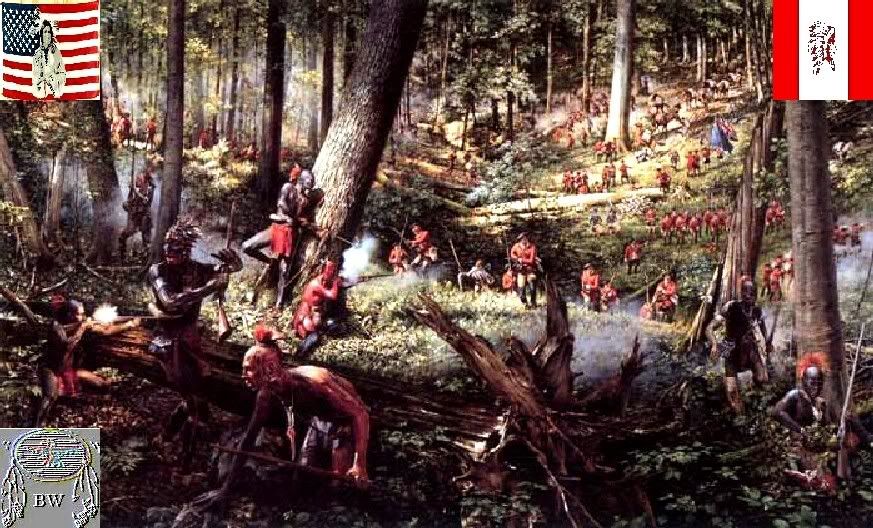|
BRAVEHORSE WARRIOR Hotsinonhyahtaa
Onondaga Warrior

 Chief Hotsinonhyahtaa
Warrior Citation
HOTSINOĐHYAHTA├ (written Chenughiyata, Chinoniata, KotsinoghyÔtÓ, Otsinughyada, Rozinoghyata), Onondaga chief; fl. 1748–74.
The name the Bunt, by which he was generally known to the British: may be a corruption of the German band, a cord or sinew,
since that is the meaning of his Onondaga name. Hotsino˝hyahta├ was acquainted with the British as early as 1748. He may
have been Racsenagate, one of the Onondagas who in March 1751 (o.s.) agreed to deed a large piece of land near their village
to William Johnson rather than sell it to the French as some of their nation had proposed. In the summer of 1756, when Johnson
(now superintendent of northern Native Americans) accompanied a delegation of Six Nations sachems to a condolence council
at Onondaga (near Syracuse, N.Y.), Hotsino˝hyahta├ received the mourners. Later that year he sent Johnson word that he was
going to Canada and would report on his journey. The meeting Hotsino˝hyahta├ attended at Montreal in December was a large
one composed of high French officials and representatives of the domiciliated Native Americans living near Montreal and of
the Ottawas and Potawatomis from the pays d’en haut. Governor Vaudreuil [Rigaud] had called the conference to solicit
the neutrality or support of the native people in the war which had broken out between the French and British. Hotsino˝hyahta├
stressed the neutrality of the Six Nations and promised to burn the British forts in their villages. When he returned home
in the spring of 1757 he sent Johnson word that the French were planning an attack on German Flats, a part of the Mohawk valley
near the mouth of West Canada Creek. At a meeting with Johnson in June the Onondagas, Cayugas, and Senecas emphasized their
intention to remain neutral. In the summer of 1758 Hotsino˝hyahta├ went to meet Paul-Joseph Le Moyne de Longueuil near Chouaguen
(Oswego, N.Y.). He warned Longueuil, an adopted son of the Six Nations, that the British were assembling men and barges at
Fort Bull (east of Oneida Lake) and that an attack on Fort Frontenac (Kingston, Ont.) was rumored – an attack which
occurred a few weeks later. Hotsino˝hyahta├) went to Canada in the autumn of 1758. On his return he advised Johnson that a
French expedition was preparing to go against Fort Stanwix (Rome, N.Y.).
Chief Hotsinonhyahtaa
Warrior Citation
HOTSINOĐHYAHTA├ (written Chenughiyata, Chinoniata, KotsinoghyÔtÓ, Otsinughyada, Rozinoghyata), Onondaga chief; fl. 1748–74.
The name the Bunt, by which he was generally known to the British: may be a corruption of the German band, a cord or sinew,
since that is the meaning of his Onondaga name. Hotsino˝hyahta├ was acquainted with the British as early as 1748. He may
have been Racsenagate, one of the Onondagas who in March 1751 (o.s.) agreed to deed a large piece of land near their village
to William Johnson rather than sell it to the French as some of their nation had proposed. In the summer of 1756, when Johnson
(now superintendent of northern Native Americans) accompanied a delegation of Six Nations sachems to a condolence council
at Onondaga (near Syracuse, N.Y.), Hotsino˝hyahta├ received the mourners. Later that year he sent Johnson word that he was
going to Canada and would report on his journey. The meeting Hotsino˝hyahta├ attended at Montreal in December was a large
one composed of high French officials and representatives of the domiciliated Native Americans living near Montreal and of
the Ottawas and Potawatomis from the pays d’en haut. Governor Vaudreuil [Rigaud] had called the conference to solicit
the neutrality or support of the native people in the war which had broken out between the French and British. Hotsino˝hyahta├
stressed the neutrality of the Six Nations and promised to burn the British forts in their villages. When he returned home
in the spring of 1757 he sent Johnson word that the French were planning an attack on German Flats, a part of the Mohawk valley
near the mouth of West Canada Creek. At a meeting with Johnson in June the Onondagas, Cayugas, and Senecas emphasized their
intention to remain neutral. In the summer of 1758 Hotsino˝hyahta├ went to meet Paul-Joseph Le Moyne de Longueuil near Chouaguen
(Oswego, N.Y.). He warned Longueuil, an adopted son of the Six Nations, that the British were assembling men and barges at
Fort Bull (east of Oneida Lake) and that an attack on Fort Frontenac (Kingston, Ont.) was rumored – an attack which
occurred a few weeks later. Hotsino˝hyahta├) went to Canada in the autumn of 1758. On his return he advised Johnson that a
French expedition was preparing to go against Fort Stanwix (Rome, N.Y.).
 Johnson’s capture of Fort Niagara (near Youngstown, N.Y.) in July 1759 encouraged Iroquois participation on the British
side in the war. Hotsino˝hyahta├ and his sons joined the forces gathered at Oswego (being rebuilt by the British) for an attack
down the St Lawrence. The expedition was postponed, but Hotsinonhyahta├ returned the next year and accompanied Amherst and
Johnson to Montreal. In September 1762 Hotsino˝hyahta├ informed Johnson that “being very old” he needed help in
managing the affairs of the Six Nations Confederacy. He asked that his two assistants be given identification papers so that
they would be known at the various posts. In following years he attended numerous conferences with the British and privately
advised Johnson on various occasions. The missionary Samuel Kirkland described him in 1765 as “a venerable old chief
. . . [who] spoke like a Demosthenes.” In the autumn of 1768 Hotsino˝hyahta├ took part in the negotiations at Fort Stanwix
in the course of which the Six Nations and their dependent tribes gave up a large amount of their land to the whites and agreed
to a boundary line that was supposed to protect their remaining territory. The treaty was witnessed by one chief for each
Iroquois nation; Hotsino˝hyahta├ signed for the Onondagas. The old chief decided to retire in 1771, but Guy Johnson, Sir William’s
deputy, persuaded him to withdraw his resignation. Hotsino˝hyahta├ now found walking difficult, and the Native American department
accounts for 1771 and 1772 show the purchase of a bateau for him. In 1773 he accompanied Christian Daniel Claus, another deputy,
to a conference at Canassadaga, the Iroquois village on Lac des Deux-Montagnes (Que.). The Six Nations at this time were concerned
with reuniting to the Confederacy those who had separated themselves from it during the wars between Britain and France, and
this objective may have prompted the old man to make the journey. In 1774 his resignation on account of his great age was
announced, and his long career as a diplomat and politician came to a close. From: historical accounts & records
Johnson’s capture of Fort Niagara (near Youngstown, N.Y.) in July 1759 encouraged Iroquois participation on the British
side in the war. Hotsino˝hyahta├ and his sons joined the forces gathered at Oswego (being rebuilt by the British) for an attack
down the St Lawrence. The expedition was postponed, but Hotsinonhyahta├ returned the next year and accompanied Amherst and
Johnson to Montreal. In September 1762 Hotsino˝hyahta├ informed Johnson that “being very old” he needed help in
managing the affairs of the Six Nations Confederacy. He asked that his two assistants be given identification papers so that
they would be known at the various posts. In following years he attended numerous conferences with the British and privately
advised Johnson on various occasions. The missionary Samuel Kirkland described him in 1765 as “a venerable old chief
. . . [who] spoke like a Demosthenes.” In the autumn of 1768 Hotsino˝hyahta├ took part in the negotiations at Fort Stanwix
in the course of which the Six Nations and their dependent tribes gave up a large amount of their land to the whites and agreed
to a boundary line that was supposed to protect their remaining territory. The treaty was witnessed by one chief for each
Iroquois nation; Hotsino˝hyahta├ signed for the Onondagas. The old chief decided to retire in 1771, but Guy Johnson, Sir William’s
deputy, persuaded him to withdraw his resignation. Hotsino˝hyahta├ now found walking difficult, and the Native American department
accounts for 1771 and 1772 show the purchase of a bateau for him. In 1773 he accompanied Christian Daniel Claus, another deputy,
to a conference at Canassadaga, the Iroquois village on Lac des Deux-Montagnes (Que.). The Six Nations at this time were concerned
with reuniting to the Confederacy those who had separated themselves from it during the wars between Britain and France, and
this objective may have prompted the old man to make the journey. In 1774 his resignation on account of his great age was
announced, and his long career as a diplomat and politician came to a close. From: historical accounts & records
|

